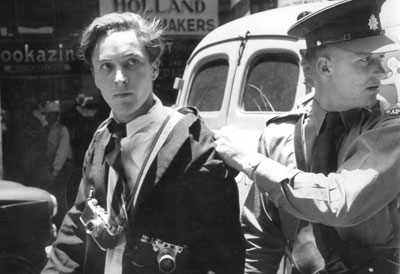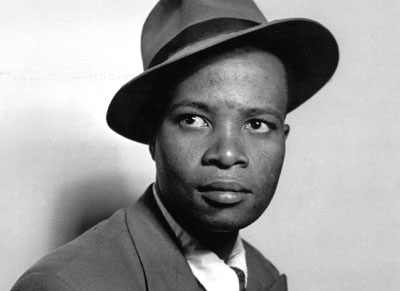Just over 55 years ago, on New Year’s Eve 1957, trailblazing South African journalist Henry Nxumalo was murdered while investigating suspicious deaths at an abortion clinic in Sophiatown, a suburb west of Johannesburg.
A local journalist assassinated while covering a local story, Nxumalo could be just one among the 631 journalists silenced by murder since CPJ began systematically documenting media fatalities in 1992. However, Nxumalo’s short-lived journalism career was remarkable — he operated as one of the first black journalists under apartheid and pioneered undercover investigative journalism in South Africa.
Dubbed “Mr. Drum” after the title of his publication, Drum magazine — which just marked its 60th anniversary as the premier publication targeting urban black readers — Nxumalo was the magazine’s first black writer, according to journalist Sylvester Stein, author of the biography “Who Killed Mr. Drum?” Stein edited the magazine from 1955 to 1958, hiring, among others, Nxumalo and German photographer Jurgen Schadeberg.
“When I arrived in South Africa I tried to freelance, but it was very difficult because there was no history of documentary photojournalism. There was no real photo magazine,” Schadeberg said in a recent telephone interview from his home in Berlin. “We had Life in America, Look magazine in England, Pixar Post in France, but nothing like that in South Africa,” he said. “I went to Drum. There were four people,” including Nxumalo, whom Schadeberg described as a “very good journalist, very courageous.” A World War II veteran, Nxumalo also wrote a regular column for the Pittsburgh Courier, Schadeberg said.
“We were doing investigations about [working] conditions in the district where there were potato farmers. Farmers had the reputation of terrorizing workers, using children as slave laborers, killing people and exploiting them. I went with him in the area. He signed up as labor in order to do the story, which is pretty tough.” Schadeberg recalled another investigation by Nxumalo on detention conditions at Johannesburg’s central prison, known as “The Fort,” which was notorious for torturing prisoners. “[Henry] found a way to get into prison — he tried for two weeks. He tried to get very drunk and walked up and down a police station singing. Police wouldn’t lock him up.” Eventually, Nxumalo managed to get arrested and spent five days in the prison. His exposé caused uproar and the government, keen to suppress similar stories, eventually passed a law restricting reporting on conditions in South African prisons. “We did a lot of stories together. With all the horrors, we had a lot of laughs,” Schadeberg said.

Those horrors stemmed from the racist policies of apartheid. Drum operated in a small office in Sophiatown, from which the apartheid regime forcibly evicted a diverse mix of blacks, “coloreds,” Indians and Chinese between 1955 and 1960, relocating them to townships outside Johannesburg. The town was subsequently bulldozed, repopulated with whites, and renamed Triomf (Afrikaans for “Triumph”). “Those days, black people’s education was suppressed deliberately by the [ruling National Party] government. There were some papers for the black population, but they were paternalistic and ran by whites. There was no news about their events, their points of view,” Schadeberg said.
White Afrikaners were consistently uneasy when Nxumalo introduced himself as a journalist, Schadeberg said. “They couldn’t handle it. We interviewed a white official. Henry was asking a question. When he talked to Henry, he used a voice with authority and superiority. If [the official] talks to me, he has a specific type of voice because I’m white. He had to change his voice all the time. He started stuttering!” Schadeberg recalled another occasion, when a policeman he described as a “very young, tough Afrikaner” put a pistol to Schadeberg’s head as he was the first reporter on the scene of a bombing of government buildings by fighters of the African National Congress.
Drum also covered the 1956 high-profile treason trial of 156 anti-apartheid activists including Nelson Mandela. “I photographed Mandela first in 1951, then again in 1952. We used to meet at a printing shop, we had brandy,” Schadeberg said. “Walking into Drum was like leaving South Africa, and coming into a different world,” Schadeberg said of the magazine, adding that its writers came from missionary schools which were mixed and had better education than the segregated schools.
The apartheid government had Drum in its sights. “The Special Branch tried to blackmail some of our people when they went for [their] passport, or permit – they tried to infiltrate the Drum office.” Eventually, Drum went bankrupt in the late 70s-early 80s, and was acquired by the then-pro-National Party newspaper group Naspers, according to Schadeberg.
Nxumalo was only in his mid-30s at the time of his murder, Schadeberg said. “There was a doctor who was attached to a police station in the area, and it was known that there had been some botched abortions, some of the patients died. [Henry] tried to investigate it. He went to talk to nurses.” Nxumalo was stabbed while walking home after meeting a colleague for drinks. “We tried to investigate, but police were sloppy about it. They weren’t interested.” (Unfortunately, this is an all too familiar pattern in anti-press violence, where murder represents the ultimate tool of censorship and where authorities lack political will to deliver justice. The killers of journalists escape justice in 9 out of 10 cases, CPJ research shows. CPJ is waging a global campaign to combat this culture of impunity, which breeds a lasting culture of self-censorship for colleagues of the murdered journalist.) In fact, while Nxumalo was survived by a wife and three children, the hard-hitting investigative journalism he pioneered at Drum did not endure, as the magazine gradually did fewer and fewer such stories.
While no one was ever arrested or convicted for Nxumalo’s murder, his colleagues were able to shed some light on the circumstances of his murder. Schadeberg said they were able to track down two criminals whom they believed were hired to carry out the killing. “One of them ended up in prison and he told his story to another prisoner. He said he got 200 pounds [sterling] for it.”
